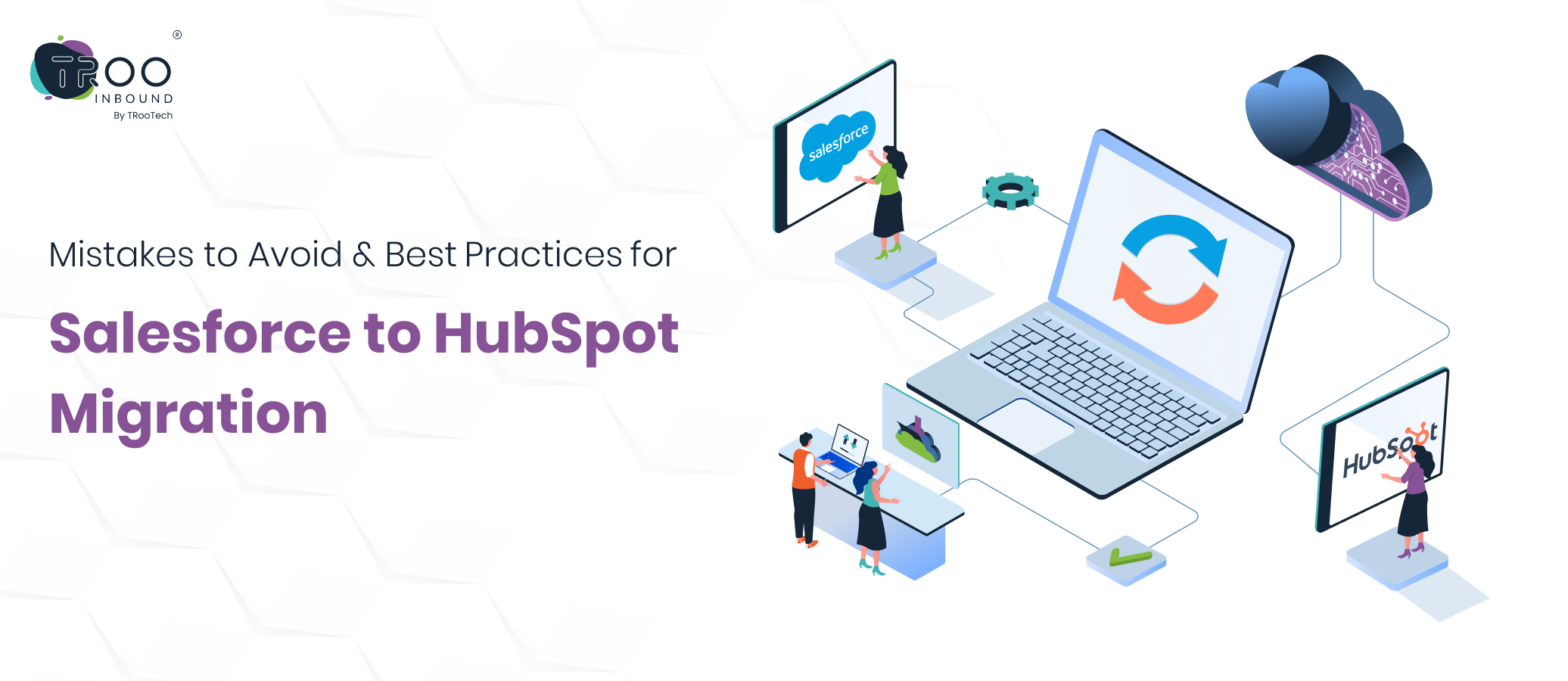Didn’t Discover!!
What You're Looking For?
Didn’t Discover!!
What You're Looking For?
Home Web Migration Mistakes to Avoid & Best Practices for Salesforce to HubSpot Migration

 By
Aman Bhati
By
Aman Bhati
CRM migration is a complex and necessary decision for businesses over time.
Many companies are transitioning from Salesforce to HubSpot because it offers user-friendly features with cost-effective scalability.
But to be honest, it isn’t as easy as it sounds. Salesforce to HubSpot migration is a strategic data transfer process that is carried out after careful planning to avoid data loss, downtime, and frustrated teams.
If you’re managing the migration or taking help from a professional HubSpot migration services provider, knowing what not to do is important.
Scroll down to find the list of common mistakes to avoid, CRM data migration best practices, and more to switch between CRMs with confidence.
There’s no doubt that Salesforce is a powerful enterprise CRM, but businesses are shifting to HubSpot because:
For deeper insights into the why and how of Salesforce to HubSpot migration, check out our Salesforce to HubSpot Migration Comprehensive Guide.
While migrating from Salesforce to HubSpot, even experienced teams can get trapped in silly mistakes when in a hurry. So, here’s the list of common pitfalls to avoid to keep your migration smooth:
Implementing CRM migration without a clear plan leads to a confused workforce, missed deadlines, and clumsy technologies. You need a roadmap that outlines:
Without this, even the best HubSpot migration services can struggle to deliver the expected results.
One of the biggest pitfalls of the Salesforce to HubSpot migration is not reviewing and refining your current data. Importing such unclean data may slow down the new CRM and also reduce its usefulness. So, before migration, you should:
Keep a practice of having data backups of your complete data set before migrating to a new CRM. In any adverse case of data loss or system failure, it will be a lifeline for your business to operate smoothly like before.
Let’s understand this with an example: In Salesforce, you have one data field called “Lead Source” that may not directly match a HubSpot property, requiring the addition of a custom property through HubSpot CRM customisation.
HubSpot’s permission settings are simpler than Salesforce’s, but that doesn’t mean you should ignore them. Common mistakes include:
The right HubSpot implementation strategy ensures each user has exactly the access they need.
The HubSpot’s automation is powerful, but it works differently from Salesforce. You may need to rebuild workflows using HubSpot’s automation tools to match your current sales and marketing processes.
Testing is essential. Skipping it means you could launch with broken workflows, missing data, or sync errors. Run a pilot migration, check records for accuracy, and ensure automations work as expected before switching fully to HubSpot.
Learning from common mistakes is one thing, but moving forward by implementing these best practices makes CRM migration easy:
Bring stakeholders, sales, marketing, and support teams into the conversation from day one. Their feedback will ensure your HubSpot CRM customization matches actual business needs.
Run a partial migration with a sample dataset to confirm field mapping, integrations, and workflows before moving everything over.
If you want a phased migration, start with the HubSpot-Salesforce integration. It allows you to sync contacts, companies, and deals between HubSpot and Salesforce, giving your team time to adapt to HubSpot while keeping Salesforce operational.
Working with an experienced HubSpot partner agency like TRooInbound reduces downtime, prevents costly errors, and ensures data accuracy. We offer HubSpot migration services tailored to your industry and goals. Hire our experts today and experience a smooth CRM transition from day one.
Configure deal stages, contact properties, dashboards, and reports so your migrated data fits seamlessly into your team’s workflow.
Team training is critical for the adoption of a new CRM. With a clear HubSpot implementation strategy, your team will know all the valuable features of HubSpot that are necessary for improving ROI.
Completing your Salesforce to HubSpot migration is only half the job. The other half means verifying that all your data works fine and nothing is broken.
Review your existing records and check that all contacts, companies, deals, and notes have been transferred without missing fields or formatting errors.
Next, test all automations and workflows to confirm they trigger correctly and align with your updated processes. Also, check on all previous integrations and any third-party apps to ensure everything is integrated correctly.
Finally, verify permissions and user roles to make sure each team member has the right level of access. Too much access can lead to accidental changes, while overly restricted access can hinder productivity.
By following this checklist, you can avoid post-migration surprises and ensure your team is fully equipped to use HubSpot efficiently from day one.
A successful Salesforce to HubSpot migration is all about moving data to a new CRM and setting it up for your organization’s long-term success.
By avoiding common mistakes such as migrating unclean data, skipping field mapping checks, or neglecting automation differences, you protect the integrity of your CRM.
At the same time, following smart tips and best practices like data auditing, using the official HubSpot-Salesforce integration, and leveraging professional HubSpot migration services ensures the transition is smooth and strategically aligned with your business goals.
With the right HubSpot implementation strategy and proper HubSpot CRM customization, your team can unlock more efficient workflows, deeper insights, and better customer experiences from day one.
If you’re ready to migrate with confidence, our team at TRooInbound specializes in delivering seamless, error-free transitions. Let’s connect today!

Dive into other interesting, well-researched, and nicely structured blog posts
 a CTA
a CTAWe will strategize our execution based on your requirement
Stay up to date by subscribing to our newsletter.

Call
+91 27174 54342

Email Address
hello@trooinbound.com

Skype Id
nikhil.jani

Schedule A Meeting
meeting/nikhil-jani
Copyright © 2025, TRooInbound. All Rights Reserved.